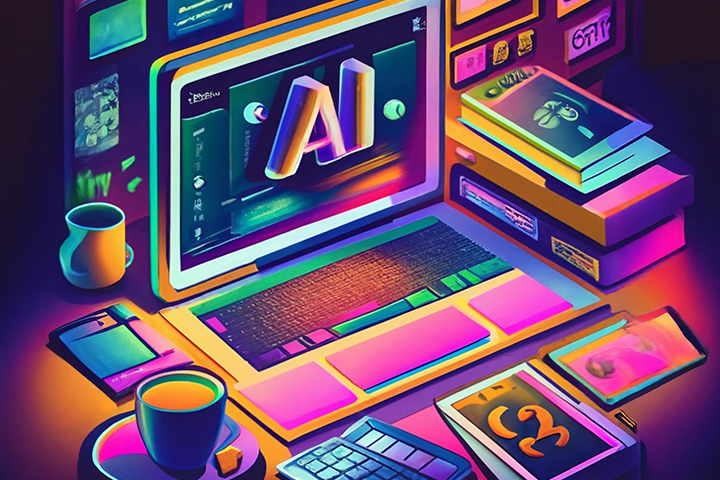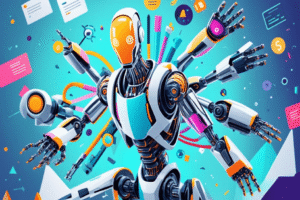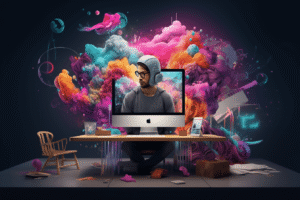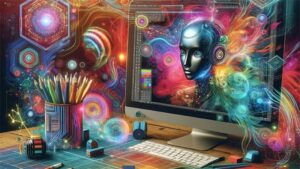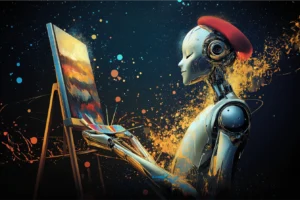In the fast-paced world of graphic design, the integration of AI for advanced graphic designers has sparked a revolution. The role of artificial intelligence in enhancing creativity and efficiency is undeniable. As technology continues to evolve, so does its impact on the field of graphic design, offering tools and techniques that redefine the creative process.

The Evolution of AI in Graphic Design
The journey of AI in graphic design began with simple automation tasks, but it has rapidly evolved into a sophisticated tool that aids designers in complex projects. Today, AI can assist in generating design ideas, optimizing workflows, and even predicting design trends. This evolution has opened new avenues for designers, allowing them to focus more on creativity and less on repetitive tasks.
How AI is Revolutionizing Design Tools
AI-powered design tools have become an integral part of the modern designer’s toolkit. These tools leverage machine learning algorithms to offer features such as automated image editing, smart cropping, and color palette suggestions. For instance, platforms like Fotor’s AI design tools provide designers with the ability to create stunning visuals with minimal effort.
Automated Image Editing
One of the most significant advantages of AI in design is its ability to automate image editing. With AI, designers can quickly retouch photos, remove backgrounds, and enhance images with just a few clicks. This automation not only saves time but also ensures consistency across design projects.
Predictive Design Trends
AI’s predictive capabilities are a game-changer for designers looking to stay ahead of design trends. By analyzing vast amounts of data, AI can forecast upcoming trends, allowing designers to create forward-thinking designs that resonate with audiences. For more insights on how AI predicts design trends, visit AI Predicts Design Trends.
Enhancing Creativity Through AI
While some may fear that AI stifles creativity, the opposite is true. AI acts as a catalyst for creativity by providing designers with new perspectives and ideas. By automating mundane tasks, designers have more time to experiment and innovate, pushing the boundaries of traditional design.
AI-Driven Idea Generation
AI tools can generate design concepts based on specific inputs, helping designers brainstorm and refine ideas. These tools analyze existing designs and suggest variations, enabling designers to explore new styles and techniques.
Collaborative Design Platforms
AI-powered collaborative platforms allow designers to work together seamlessly, regardless of their location. These platforms facilitate real-time feedback and iteration, fostering a collaborative environment that enhances creativity and productivity.
The Role of AI in Design Education
As AI continues to shape the design landscape, it is becoming an essential component of design education. Institutions are incorporating AI tools into their curriculum, preparing future designers to navigate the digital age proficiently. For more on the role of AI in design education, visit Role of Neural Networks.
Challenges and Opportunities
While AI offers numerous benefits, it also presents challenges. Designers must learn to adapt to new tools and techniques, ensuring they remain relevant in an ever-changing industry. However, these challenges also present opportunities for growth and innovation.
Overcoming Resistance to Change
Some designers may resist adopting AI due to fear of the unknown. Education and training are crucial in overcoming this resistance, as they help designers understand the benefits and potential of AI in their work.
Embracing Continuous Learning
The design industry is dynamic, and staying updated with the latest AI advancements is essential. Designers must embrace a mindset of continuous learning to leverage AI effectively and maintain a competitive edge.
AI in 3D Modeling and Architectural Visualization
AI’s impact extends beyond traditional graphic design, influencing areas such as 3D modeling and architectural visualization. AI tools streamline these processes, allowing designers to create more detailed and accurate models. For insights on AI in 3D modeling, visit AI for 3D Modeling.
Streamlining Architectural Visualization
In architectural visualization, AI enhances the realism of designs by generating lifelike textures and lighting. This technology enables architects and designers to present their ideas in a more compelling and immersive manner.
Improving Design Precision
AI algorithms improve the precision of 3D models, reducing errors and ensuring accuracy in design projects. This precision is particularly valuable in industries where detail is paramount, such as architecture and engineering.
Future Prospects of AI in Graphic Design
The future of AI in graphic design holds immense potential. As AI technology advances, it will continue to transform the design landscape, offering new tools and opportunities for creativity. Designers must stay informed and adaptable to harness the full potential of AI in their work.
Anticipating Technological Advancements
As AI evolves, designers can expect significant advancements in design tools and techniques. These advancements will likely focus on enhancing user experience, improving automation, and expanding creative possibilities.
Integrating AI with Traditional Design
The integration of AI with traditional design principles will become increasingly important. Designers who can seamlessly blend AI technology with classic design elements will be well-positioned to succeed in the industry.
Conclusion
The integration of AI for advanced graphic designers is revolutionizing the industry, offering new tools and opportunities for creativity. As AI technology continues to evolve, designers must embrace these changes and leverage AI to enhance their work. By staying informed and adaptable, designers can unlock the full potential of AI, transforming the way they create and innovate.

FAQs
What is the role of AI in graphic design?
AI plays a crucial role in graphic design by automating tasks, generating design ideas, and predicting trends, thereby enhancing creativity and efficiency.
How can AI enhance creativity in design?
AI enhances creativity by automating repetitive tasks, generating new design ideas, and providing collaborative platforms for designers to innovate and experiment.
What are the future prospects of AI in graphic design?
The future of AI in graphic design includes advancements in design tools, improved automation, and the integration of AI with traditional design principles, offering new opportunities for creativity.

